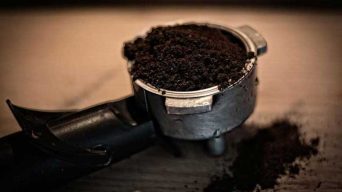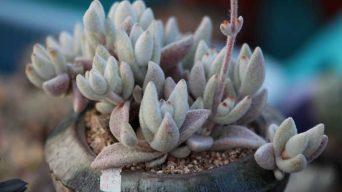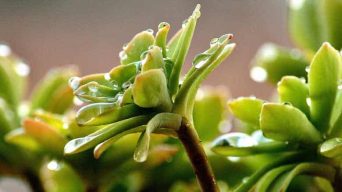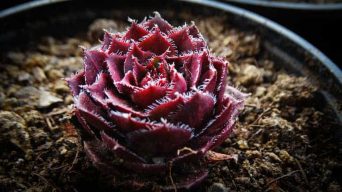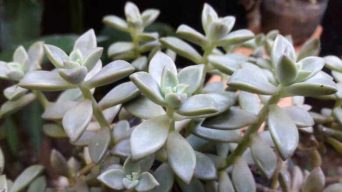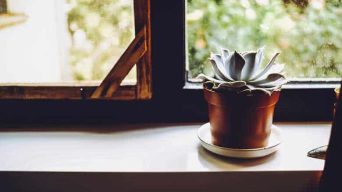Humidity is a word that can be used to refer to the amount of water vapor in the air and the amount of water vapor in the soil.
It is also a word that can refer to how comfortable or uncomfortable we feel when it’s hot and humid outside (which can happen during summertime).
If you are wondering do succulents like humidity, this article will give you all the information you need!
We’ll talk about what humidity is and why it’s important for your succulent plants, how to keep them happy in humid conditions, and some types of succulents that thrive in high levels of humidity.
What is Humidity?
Humidity refers to the amount of water vapor in the air. When there is more water in the air, it becomes humid.
The measure of humidity is done with a hygrometer or an electronic sensor that measures relative humidity (%RH).
Relative Humidity (RH) can range from 0-100%.
High Humidity
When the RH is higher than 40%, this indicates that too many particles are present for perspiration to evaporate.
This will lead to excessively high levels of heat and moisture, which might be dangerous for your succulents.
This can be caused by rain, fog, or abundant plants and trees surrounding your succulents.
Low Humidity
When the RH is below 40%, there are too few particles in the air to absorb any perspiration.
This will lead to low humidity, which can dry out your succulents and make them brittle. This can be caused by an air conditioner, the heat from a stove or fire, and extreme cold.
Why Is Humidity Important to Succulents?
In general, succulents come from areas that do not have a lot of humidity, so most succulents prefer to live in dry conditions.
Because the air and soil are very dry where they come from, these plants cannot tolerate high levels of moisture or excessive heat.
Humidity is important for succulents because it helps them regulate their water intake.
Without humidity, the air and soil are very dry, which causes the plant to absorb moisture from its surroundings to survive constantly.
This absorption will cause the plant’s leaves to droop as they try to take up more of the little available water around them.
This can sometimes lead your succulent to wilt or even die on a hot day!
In addition, a hot and humid environment can cause your outdoor succulent garden to become stressed out faster because it changes the water balance within each cell.
It also increases the chances that pests will invade, such as mealybugs, snails, or slugs; this pest damage decreases plant health overall.
The best way to tell if your houseplant needs more humidity is by feeling for dryness of the soil or a slight wilting. If this occurs, you likely need to increase the moisture level in that area with occasional misting from time to time, as long as it doesn’t become too humid.
What Are the Best Humidity Conditions for Succulents?
Many different factors affect what the best humidity for succulents is.
When deciding on a humidity level, it is necessary to understand how your plants grow and their water requirements.
In general, most succulents do well at low humidities because they can store more moisture in their leaves than other types of succulent species.
Succulents do not like humid conditions, but they can tolerate it for a little while.
The best humidity levels for succulents are around 40% to 60%. If the humidity is above this percentage, then the risk of rot and fungal diseases increases.
Too much moisture from high humidity conditions can lead succulents into developing root rot due to poor drainage and excess standing water on top of their roots.
In addition, with higher levels of ambient heat during the summer months (higher temperatures), increasing levels of atmospheric water content may increase the risk for fungal disease.
How Can You Measure the Humidity Levels for Succulents?
The best way to measure the humidity levels for succulents is by using a hygrometer.
You can place this device inside your growing space. It will help you take readings every day.
All these measurements should be taken in Fahrenheit degrees because they work better with higher temperatures (this temperature scale measures water vapor content).
If you notice over 75% humidity during summer months, too much moisture might accumulate on top of their roots which causes them to rot and die off.
Tips for Keeping Your Succulents Happy in Humid Conditions
When you have succulents in a humid environment, some tips can help you keep your succulents healthy and happy:
- Provide the succulents with drainage – Succulent roots do not tolerate standing water. Therefore, they should be planted in a pot for proper drainage.
- Leave some air space around the succulents when you place them on your windowsill. This will give them more oxygen than if they are directly against or under glass.
- Make sure to use a soil mix low in peat moss and other organic matter because it retains moisture, which can lead to root rot.
- When watering succulents, gently soak the soil until moist but avoid wetting leaves as much as possible. Excess humidity can make these fragile plants susceptible to fungus problems like powdery mildew.
- Consider using a humidifier to raise the humidity levels in your home or office.
- Mist your succulents with a spray bottle when the air feels too dry.
- Consider placing some plants on the south side of your home or office since they may help raise humidity levels in that area.
Types of Succulents That Like High Humidity
Many different types of succulents do well with slightly higher humidity levels. Some examples include:
Portulacaria Afra
The Portulacara afra can thrive in humid or dry environments; however, they need soil that drains well and adequate sunlight conditions (indirect sunlight).
Given these needs, this succulent plant will survive fine even when living outside during the warmer months.
The Portulacara afra is one of the succulent varieties that like humidity and can do well in temperate climates with high relative humidity when planted outdoors during the summer.
In contrast to other plants, this succulent does not need damp soil all year round. But instead needs enough moisture so that air bubbles disappear from the surface of the potting mix.
Crassula Ovata (Jade Plant)
Crassula ovata is also known as the Jade Plant. This succulent has flat, oval-shaped leaves that are grayish-green with silver markings on them, and it grows to a height of about 12 inches tall.
The Crassula ovata does not do well in dry conditions but thrives when exposed to high humidity levels.
For your crassula ovata to thrive, you must place it in a humid environment where temperatures stay between 60°F during the winter and 80°F during the summer months.
These plants should be watered once every week or two, depending on how much sunlight they get each day-these plants like being overwatered just enough so their soil feels moist but never wet.
Sedum (Stonecrop)
Sedum, also known as Stonecrop, is one of the most popular succulents for beginners and has a wide variety.
They are often called “impossible plants” because they can thrive in extreme hot or cold temperatures (-40°F/-20°C) if given enough sunlight.
It likes humidity levels that fluctuate between 60%-80% with good airflow but will do well at 30%-50% with little water as long as it gets plenty of light daily.
It’s recommended not to overwater Sedums because this may cause them to rot. This happens when too much moisture gathers around their roots due to a lack of air circulation in the potting soil.
However, don’t let them dry out because they will wilt and die.
Sedums have to be watered at least every three days in humid climates, or their leaves may droop from dehydration.
Kalanchoe Blossfeldiana
Kalanchoe blossfeldiana is a succulent that originated in South Africa. It has green leaves and orange flowers.
The plant thrives best when grown indoors under warm, humid conditions of 50-60 degrees Fahrenheit during the day and 65-70 degrees at night.
Once Kalanchoe blooms, it will need less water than before to maintain its health because the plants go dormant over the winter months (November through March).
They require more watering every few days in the summer, depending on their size and how much sun exposure they’re getting outside.
When you give them a drink, wait until nighttime for maximum humidity benefits!
Final Thoughts
In conclusion, do succulents like humidity? The short answer is: No, succulents do not like high humidity levels.
They can do well in low-humidity environments and thrive when the conditions are just right. A humidifier may be necessary to maintain these levels if your succulents get too dry or want them to grow faster (depending on where they live).
Each type of succulent needs different humidity levels, so the key is to research and ensure you provide the right conditions.


